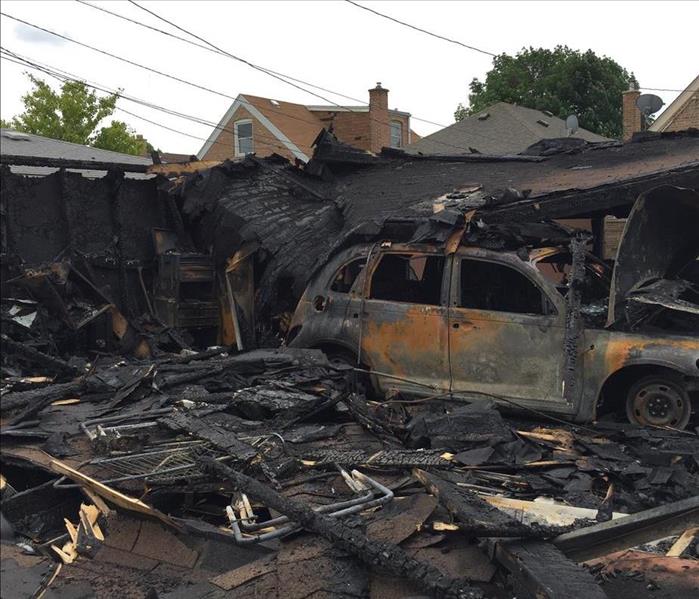Effective Ways of Removing Fire and Smoke Residues from My Chicago Home
8/21/2022 (Permalink)
 Fire damage cleanup is not a DIY job for this Chicago property owner. Call SERVPRO for professional help.
Fire damage cleanup is not a DIY job for this Chicago property owner. Call SERVPRO for professional help.
Count on SERVPRO to Use Industry Best Practices for Fire Damage in Chicago
The hours and days you spend recovering from a fire in your house are not the time for you to shoulder the brunt of the cleanup. As the fire made its way through your home, it consumed building materials and contents, leaving chemicals and compounds floating in the air and adhering to many surfaces.
Should You Try to Clean Fire Residues as a DIY Project?
Because of the hazardous nature of the residues, experts recommend against completing fire and smoke cleanup of your Chicago dwelling on your own.
How Do Professionals Approach Fire and Smoke Cleanup?
The Fire and Smoke Restoration Technicians (FSRT) at SERVPRO realize that deep cleaning is essential to returning your home to its preloss condition. The cleaning techniques, tools, and products used vary depending on the type of soot and the surface coated. Efforts to remove the soot must balance with the durability of the surface, or the affected materials might need removal and replacement at a more considerable expense and disturbance.
Is There One Cleaner that Can “Do it All” When Resolving Soot Damage?
One of the fundamental things our managers and technicians learn during certification and follow-up courses from the IICRC is that the characteristics of fire residues vary greatly depending on the fuel consumed during the fire. Because the materials and contents burned from room to room change, our crews must be alert as to the consistency of the soot on each surface, changing products and methods frequently for best results. Selecting just one master cleaner for all soots and damaged surfaces result in poor outcomes for many spaces and articles damaged by the fire.
What Are Examples of Types of Soot Appropriately Matched with Products and Techniques?
Soot has three main types--dry, wet, and protein-based, the latter from kitchen fires. Here are the most commonly used approaches our crews take when managing each.
What Are Best Practices for Dry Soot?
The residues deposited after a hot, high-oxygen paper or wood-fueled fire are loose and ashy, responding well to brushing, dry (chemical) sponging, vacuuming, and feather or cloth dusting. Wiping or scrubbing at the friable debris smears this soot, grinding it into the surfaces, staining and scraping them, and leaving odors embedded.
What Are Best Practices for Wet Soot?
Sticky and thick, this soot occurs when plastics, rubber, textiles, and padding burns or smolders at low temperatures and oxygen levels. Our project managers determine whether the soot is water or oil-based and choose like-formulated cleaners to remove. When cleaning up wet soot, our technicians first test inconspicuous areas to ensure the surfaces can withstand the combination of products. Applying the cleaning elements is usually successful at removing soiling of this kind. The elements of cleaning include:
- Agitation--towels, brushes, air and water pressure, and sonic vibrations in special ultrasonic machines all work to dislodge the debris mechanically
- Chemical action--provided by the cleaning products chosen
- Temperature--higher temperatures accelerate the chemical action
- Time--dwell time is the period a product is allowed to soak into the residue, breaking the bonds between the residues and the surfaces before rinsing or wiping
What Are Best Practices for Protein-Based Soot?
The residues left after food or grease “burns” are more like what remains after complete dehydration. It is mist-like when airborne and then like a varnish when deposited. The coating is highly-malodorous and tightly clings to surfaces, although it is often nearly transparent. Because of the oil base of much of this soot’s fuel, solvents are frequently needed to loosen the coating. Abrasion, an intense form of agitation, might become necessary to encourage the soot to release. Abrasive tools like sandpaper are helpful. Some cleaning products have inert abrasive substances mixed to help scrape and scrub these tough-to-clean residues off of contents and structural components.
Cutting-edge products and research-based methods are how SERVPRO of West Loop/Bucktown/Greektown efficiently cleanses a broad range of fire residues. Call us at (773) 434-9100 as soon as practical so that we can arrive as the firefighters release your property for restoration.






 24/7 Emergency Service
24/7 Emergency Service